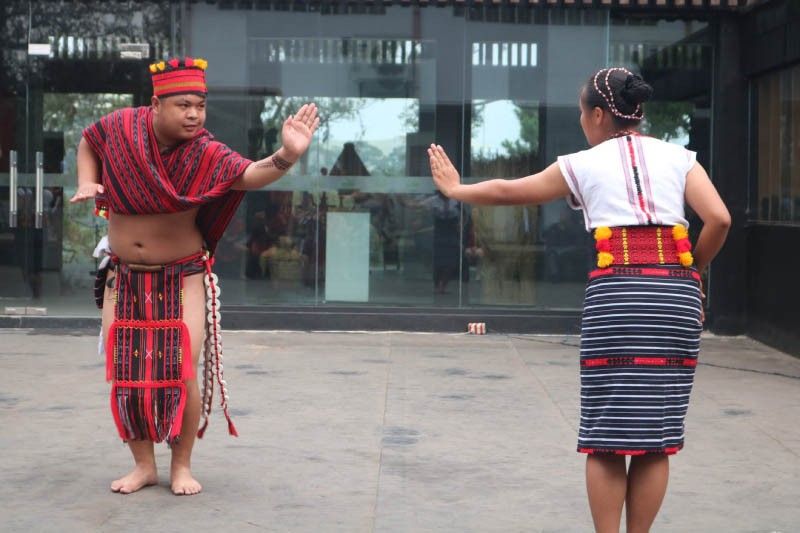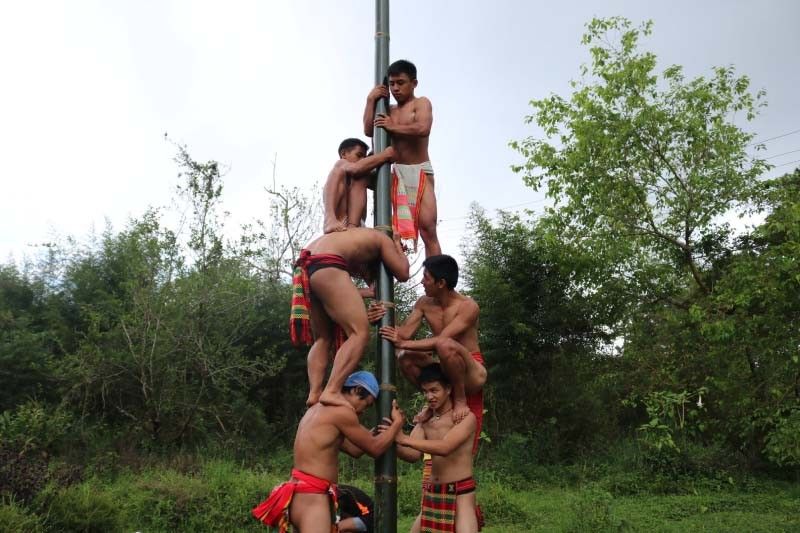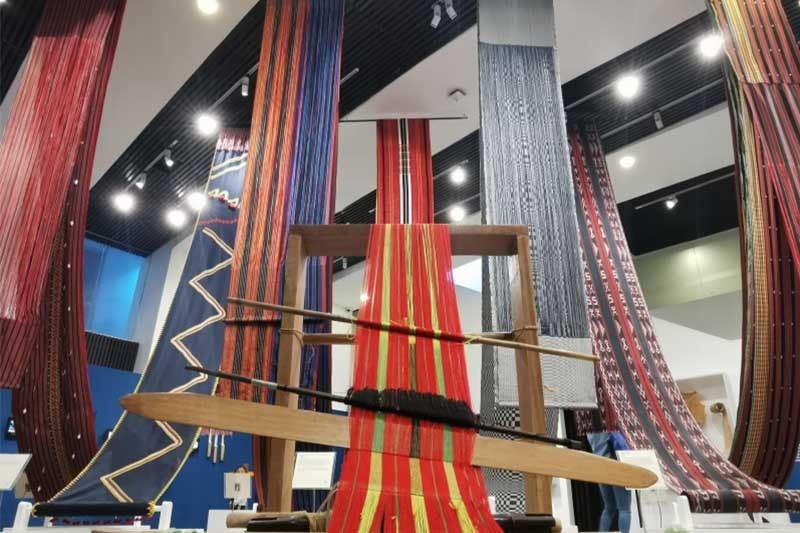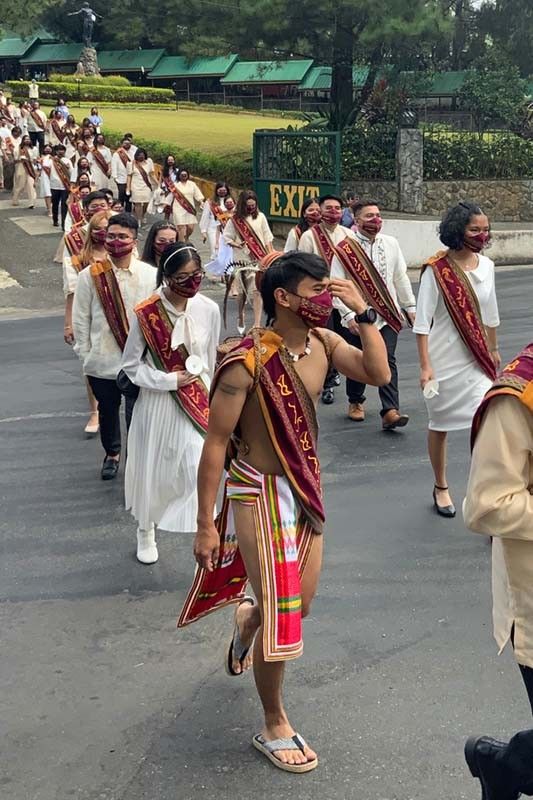Cordillera IPs assert ownership of bahag, indigenous culture against misuse

MANILA, Philippines — In the past decade, Philippine indigenous weaves and garments have received renewed interest among Filipinos and even foreigners. They have taken the spotlight in fashion shows, formal gatherings like the State of the Nation Address, and beauty pageants.
While the recognition these garments receive for their intricate beauty and cultural significance is well-deserved, Indigenous Peoples (IPs) are quick to call out use of their cultural pieces when it crosses the line from cultural appreciation to bastardization.
This was the case when candidates of the international "Man of the World" pageant in June strutted the bahag (male Igorot loincloth) in the swimwear segment. The event came under fire after making Cordilleran IPs feel that an important piece of their Igorot identity was not only erroneously presented but was also disrespected.
FROM INTERAKSYON: ‘Mali ang paggamit’: Teddy Baguilat frowns at how ‘bahag’ was presented in male pageant
Collectively referred to as "Igorots", or "people of the mountain", the people of the Cordillera region comprise seven major ethnolinguistic groups: the Kankanaey, Bontoc, Kalinga, Ifugao, Tingguian, the Apayao or Isneg, and the Ibaloy.
Indigenous activist Joan Carling writes in a 2001 piece on the Cordilla Experience that while "these are the popular reference to indigenous groups, but there are more 'peoples' as distinct as 'ili'."
"'Ili' is a self identifying group of indigenous people, with their own defined territory as their ancestral land, and their own indigenous socio-cultural systems," she also writes.
Like that of many IP groups, Cordilleran culture is underrepresented in the mainstream and is prone to caricature.
"With the advent of colonialism, indigenous peoples were considered savages who were barbaric and uncivilized because they resisted assimilation to the mainstream colonized society," Carling writes.
"Later, they were subjected to forced assimilation and development aggression which in many instances resulted in their further isolation from the so-called mainstream society."
This isolation manifests in the use of their material culture as costumes as well as in IP communities being marginalized in discussions on development policy and on how the state will use their ancestral lands.
RELATED: IP voice in local Cordillera councils weak despite law recognizing their rights
Bahag, in the eyes of Igorots
Marcos Mangallay, a researcher and a member of the Applai people in Mountain Province, was one of those who raised an eyebrow at the pageant's misuse of the bahag.
"[It was] very disturbing to see the bahag worn that way," Mangallay told Philstar.com. "It is not just that they disrespected our culture, but at the same time, it showed the world that we sometimes act out of ignorance."
In a community discussion, several IPs who preferred to not be named to protect their privacy raised their contentions over how the pageant went too far by showcasing the bahag as swimwear, which it is not.
“Ang purpose ng bahag ay to cover what needs to be covered. Walang nakikitang problema sa pagsuot ng bahag, pero ang problema ay pag iba na ang ipinapakita,” one of them told Philstar.com.
(The purpose of the bahag is to cover what needs to be covered. We do not see any problem with people wearing the bahag but the problem is when they show something else enitrely.)

Young Igorot men play a traditional game as part of the activities of the month-long celebration of the Gong Festival last October 21, 2018. Photo courtesy of: Paggawisan Tako Am-In (PAGTA)
Not only was the bahag erroneously featured as swimwear, but it was also presented in a way that elicited disrespectful and sexualized comments on social media.
Mangallay believes that the pageant's garment presentation is contrary to how a bahag should be worn and treated. He explained: "Yung sanctity kasi ng bahag na-grabehan sa presentation, since we don't really want it to get dirty. Kasi there's the sanctity of the cloth."
(The presentation was a bit much, considering the sanctity of the bahag. Since we don't really want to get it dirty because there is the sanctity of the cloth.)
The bahag, he added, is so important to them that elders would even prohibit them from washing the garments with detergent. They can only be washed with water, to preserve the garment's "sanctity."
Bahag borrowed
Borrowing a piece of culture from IPs is not entirely new in the Philippines, especially in the fashion scene any brands claim to celebrate indigenous communities' craftsmanship.
But even when IP communities are willing to share their culture — so long as they're treated with honor and respect — they are also determined to safeguard indigenous traditions and symbols from misuse and misinformation.
Lucy Ruiz, an IP Education lecturer, cautioned that misusing indigenous symbols in pageants or fashion shows might popularize erroneous information about Igorot's cultural expressions.
"Kapag pinopularize mo ang erroneous information, it results to a wrong notion,” she said. “If seen by non-IPs, maiisip nilang pwedeng gamiting ganon-ganon nalang 'yon, which we feel is offensive sa aming IPs because that's not what it is and its use.”
(When you popularize erroneous information, it results in people having wrong notions. If seen by non-IPs, they might think that you can use it however you want, which we feel is offensive to us IPs because that's not what it is and what it is used for.)
Cultural attires like bahag are not costumes nor ideally worn as fashion. They are used traditionally in agricultural activities, rituals, festivals and celebrations where IPs showcase their cultural identity.
Garments like these should not be used in the spirit of competition because cultural pieces are unique and appreciation of them should not be left to contest judges.
"When we wear our cultural attires, we wear our identity, our history, and our people — we hope that we can use events such as pageantry to make them understand that the practice of our tradition and culture is not a spectacle that should be reduced for others’ entertainment," TAKDER, a Metro Manila-based mass organization for Cordilleran youth, said of the incident.
"We are not commodities but human beings."

Cordillera indigenous textiles displayed at the Museo Kordilyera in Baguio City. Philstar.com/Jap Tobias
But for the sake of preserving the cultural value and relevance of indigenous garments, is there space for innovation?
Ruiz says there could be, but with free, prior, informed consent from the community that owns the material culture. Otherwise, these attires might completely lose their meanings and their intended use in the process of modification.
However, innovated designs should not be passed off as or labeled "indigenous" since the original form of the garment has already been refashioned.
RELATED: We need to talk about ‘Badjao Girl’ and ‘Friends’
In defense of their culture
Seeing the threats of cultural misuse and misinformation on their indigenous identity, Cordillera's IPs, researchers and cultural advocates have taken on the challenge of defending their culture.
“Mahirap na parang sa ibang communities malaman na we allow pala mga ganito [disrespect of attires]. We have to protect our community and cultural resource kasi these are our treasures," Ruiz asserted.
(There will be a problem if other communities get the idea that we allow the disrespect of our attires.)
“Kailangan na ipasa ang kultura ng mga nakaalam, kasi if they won’t do it, who else will?” Ruiz said.
(Passing on the culture should be done by those who know it. Because if they will not do it, who else will?)
In Cordilleran communities, members aim to preserve their centuries-old traditions through storytelling, filmmaking, weaving workshops and the continuous practicing of their traditional dances and rituals.
Some IPs also have taken an active role in documenting their communities, which they hope would bring forth new policies that better recognize and protect their indigenous groups and cultures.
Cultural education is also underway to combat misinformation surrounding their indigenous culture. This is done through the oral traditions of elders and culture bearers, complemented by new initiatives such as the Museo Kordilyera and the interdisciplinary Cordillera Textiles Project (CordiTex).
Groups like the Cordillera Peoples Alliance meanwhile celebrate Cordillera Day every April 24 to commemorate an attack in 1980 by the military on a hut where two leaders in a campaign against the Chico Dam project were staying. Macli-ing Dulag, a leader of the Butbut tribe was killed in the shooting, while Pedro Dungoc survived.
"The general program for the two-day celebration includes workshops on major issues affecting indigenous peoples, presentations on the regional and national situation and challenges; on experiences and lessons from struggles in defense of indigenous peoples rights and human rights and various cultural presentations presenting the issues of communities and sectors; including the tribute to Cordillera martyrs," CPA, which has organized the celebrations since 1985, says on its website.
Confronting the culture of disrespect
While IPs are more than happy to share their culture in the name of preservation, the line between appreciation and appropriation can blur easily — making it more difficult to defend the culture their ancestors have long fought for.
"We as IPs want people to understand that these things may seem like nothing to them, but we need them to understand that it means a lot to us kasi parte siya ng kultura at identity namin (because they are part of our culture and identity)," said Lumnay Guillermo, an Ibaloi-Kankanaey and a member of the student council at UP Baguio.

Professor Andrei Domogo marches wearing the “Sablay”, the academic costume of the University of the Philippines and a “wanes” (loinscloth) during his Ph.D graduation in Baguio last July 21, 2022. Philstar.com/Jap Tobias
Guillermo added that defensiveness and insensitive remarks from non-IPs when misuse of indigenous attires is called out do not help. Those in the mainstream cultural tradition should instead be open-minded if they genuinely want to appreciate and promote indigenous culture.
"If we say something is not culturally appropriate, then who are they to say it's otherwise?" she said. "We can speak for ourselves because we know our culture better than them."
Apart from all their community efforts, the IPs interviewed believe that the national government should also work on better protection of indigenous cultures, with some even pushing for penalties for the disrespect of traditions, symbols and garments.
"Kahit maglabas ng statements ang [National Commission on Indigeneous Peoples] at cultural organizations, ano ang magiging penalty? Sanctions sa mga magagawa?" one IP asked. "Anong mangyayari sa kanila for violating and disrespecting?"
(Even if the NCIP and cultural organizations issue statements, what will be the penalty? Will there be sanctions? What will happen to them for violating and disrespecting?)
They said that imposing penalties is not in their nature, and they often leave these matters to Kabunyan, the chief deity in Ifugao oral tradition. But amid repeated disrespect of their culture, interviewees told Philstar.com that maybe it's about time that they adapt and push back.
"We owe it to our ancestors to propagate what is proper and right and not to do things only for the sake of clout," shared one of them.
"Our ancestors are watching over us, matakot naman tayo. We must not anger our ancestors over half-truths and we should serve them right," she concluded.
RELATED: Presidential bets back creation of Cordillera autonomous region
- Latest
- Trending































